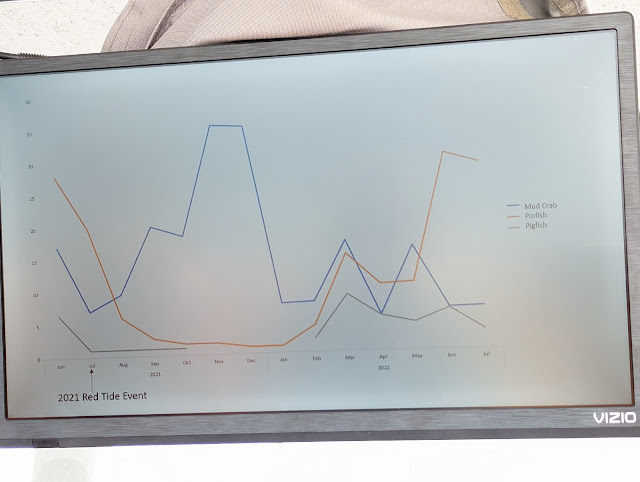This summer Mama went to camp! I was invited to attend the Harold Albers Teacher Ecology camp hosted by Sensing Nature and St Petersburg Audubon. The purpose of this week-long science camp is to educate teachers thru experiences so they can pass along an understanding of wildlife and the need for habitat conservation to their students. It was divided into two sessions. The first two days were focused on aquatic wildlife, the next three on paleontology. I attended the first session which started off with a boat ride in the Tampa Bay Estuary conducting a net two to collect data about the aquatic wildlife that lives in the sargassum (the floating vegetation). (I should mention this is part of a daily survey completed under a permit and the data is sent to Florida Fish and Wildlife.) They dropped the net and dragged it for a specific number of minutes, then moved everything from the net into the large blue tub. Next they carefully sorted thru the sargassum with small nets, removing and counting each species of fish, seahorse, etc. They kept some in a tank on the boat so we could see them up close.
We circled a protected island where tons of birds are nesting, including pelicans, herons and egrets.
Our classes were held at the Tampa Bay Watch Discovery Center so we were able to see their exhibits and wildlife. Back in the classroom, they helped us examine shark specimens and record data on them.
The Lionfish. It's such a striking fish, right? Well, unfortunately, it was never meant to live in our waters. It's native to the South Pacific and Indian Oceans, and was introduced to the Atlantic Ocean 30 years ago. Today they can be found all along the coast from Brazil, along Mexico and up to Maine.
They will eat anything that will fit in their mouth, and they have no predators, so they've really wreaked havoc on our ecosystem. They can reproduce at an incredible rate of 30,000 eggs every 4 days (that's more than 2 million eggs per year) and can live up to 15 years! Our next project was to dissect a lionfish to learn more about their anatomy.
Its 18 spines are used in defense to deliver venom that is extremely painful to humans and can cause difficulty breathing and on rare occasion, death. Thankfully, they've already been removed for our safety. He looks a bit grumpy, eh?
Pictured here is an ovary with eggs exposed and floating (bottom left), a gill (bottom right) and the stomach contents, which we believe to be a parrotfish (top). There was also a tiny shrimp, not pictured.
It was a challenge, but I was able to snap a few photos and when we compared them to the chart, we were able to identify this dolphin as Malone.
I was surprised to learn that the Tampa Bay is only about 6ft deep, except for the shipping lanes that were dredged thru it. Because this group has been collecting data on the aquatic life in found in the sargassum, they were able to chart the effect of the red tide in 2021. The pigfish and pinfish populations took a big hit that winter, while the mud crab population exploded. They eat dead fish and had fewer predators. A year after the red tide event, they were all approaching pre-red tide numbers.
We learned how installing a Living Shoreline can protect homes along the coast during storms. The Tampa Bay Discovery Center has a great display to show this in action. The vegetation reduces the reach of the waves. It also provides habitat for birds, oysters and other wildlife.
Next we learned about water quality by taking samples of the Bay and testing it. This is an activity I plan to do with my own kids and the students in our local nature club.
Now this last part was not something I was initially interested in, but it ended up being one of my favorite parts. Plankton! We used special nets to collect plankton from just below the Bay pier. After a few minutes the little bottle was packed full of tiny phytoplankton (plant) and zooplankton (aquatic microorganisms).
WOW! I saw details of so many different creatures. Things you can't even imagine. They moved so quickly it was hard to get great photos, but this gives you an idea. There were baby jellyfish, a horseshoe crab, and lots of other things. I wish everyone could experience seeing the tiniest of creatures like this. I found this the most exciting and shocking part of the camp. I am so thankful for being able to attend this special camp. It was a great experience and I'm looking forward to sharing what I've learned with others.
These are distant cell phone shots thru my scope. I didn't want to risk disturbing them.
If you are a teacher in the St Pete area, I strongly suggest applying for this camp. It's extremely educational and fun and will inspire you to share what you've learned with your students. I wish more organizations offered ecology camp experiences for adults. You can also work directly with Jeanne and Brian of Sensing Nature to book a family or group field trip, ecotour, custom program or attend one of their camps. They make learning a really fun experience! The Tampa Bay Watch Discovery Center has a mobile educational program where they will bring experiential learning to your school. Contact them for more info.

























No comments:
Post a Comment